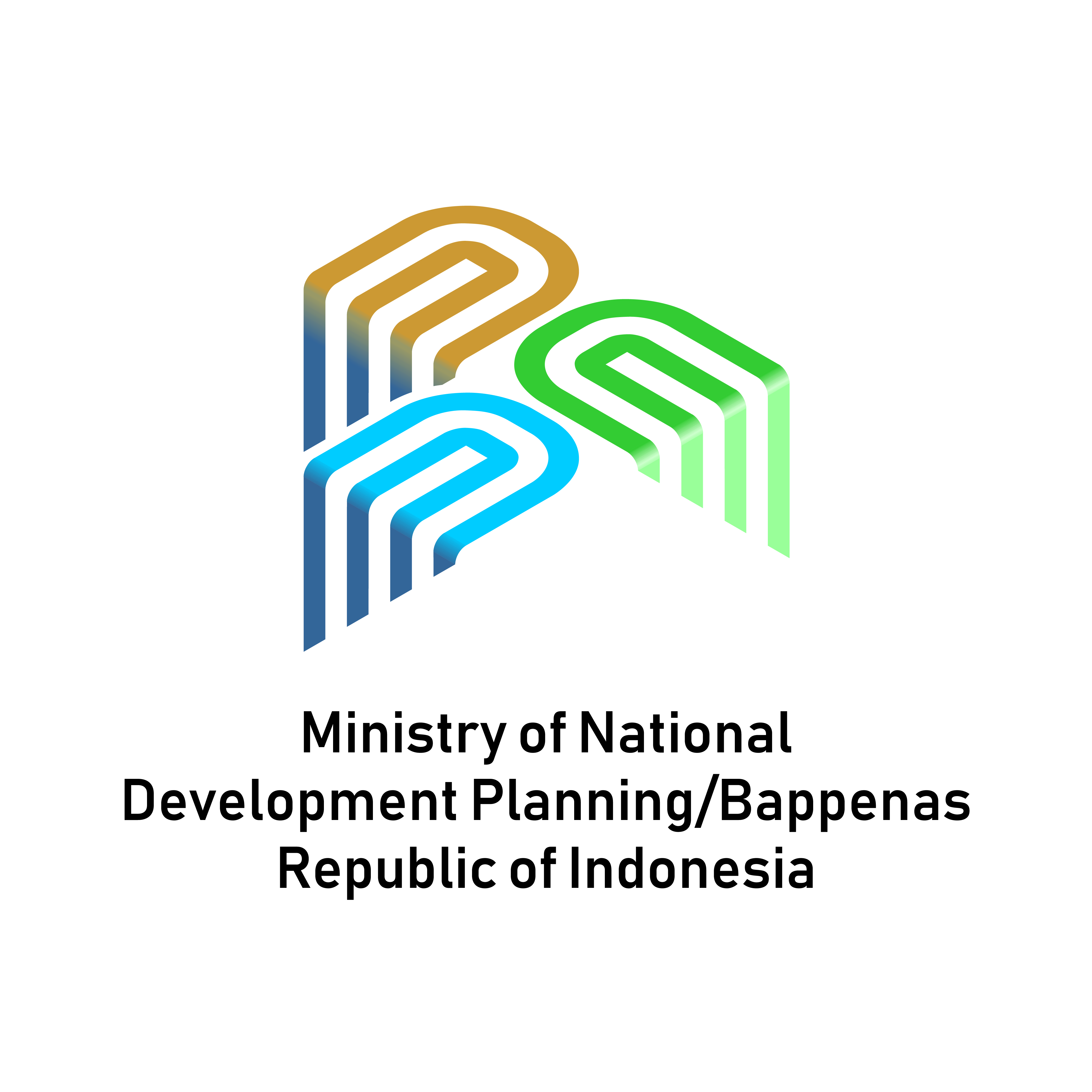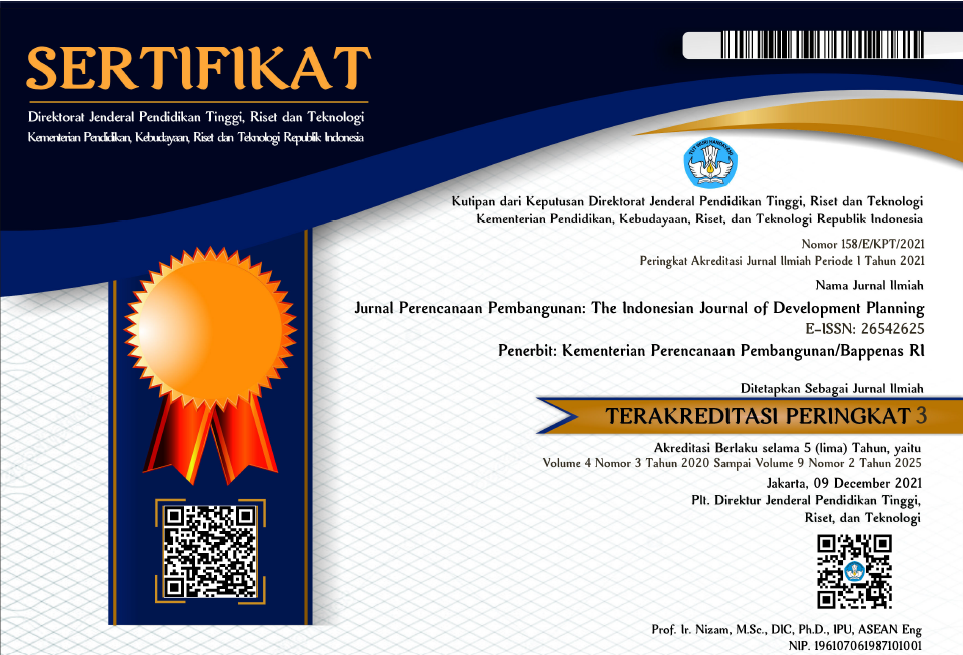Effects of Village Education and Access to Information on Mangrove Forest Areas: Studies in Indonesia
DOI:
https://doi.org/10.36574/jpp.v7i1.447Keywords:
education, access to information, mangrove, Indonesia, panel dataAbstract
This study seeks to gather empirical evidence regarding education and access to information in affecting mangrove forests in Indonesia. The motivation for this study comes from the fact that Indonesia has experienced enormous mangrove deforestation in the last three decades. This study uses village level data in Indonesia. With a combination of geospatial data and PODES, the author uses the unbalanced panel data and Fixed Effects Model (FEM) to analyze the correlation of 9-year basic education facilities and higher education as well as national private TV broadcasts and overseas TV broadcasts on the area of mangrove forests. The author found that villages that have higher education facilities and get overseas TV broadcasts have a positive correlation with the area of mangrove forests in the village area. Higher education and broad access to information globally can certainly increase villagers’ knowledge and concern about the importance of mangrove forests. Therefore, government policies are needed to improve higher education facilities and access to global information in villages to reduce the exploitation of villagers against mangrove forests, especially for village communities located around mangrove forests.
Downloads
References
Alongi, D. M. (2012). Carbon sequestration in mangrove forests. Carbon Management, 3(3), 313–322. https://doi.org/10.4155/cmt.12.20
Ashton, E. C. (2008). shrimp farming's effects on mangrove ecosystems. CAB Reviews: Perspectives in Agriculture, Veterinary Science, Nutrition and Natural Resources, 3. https://doi.org/10.1079/PAVSNNR20083003
Aye, W. N., Wen, Y., Marin, K., Thapa, S., & Tun, A. W. (2019). Contribution of mangrove forest to the livelihood of local communities in Ayeyarwaddy Region, Myanmar. Forests, 10(5). https://doi.org/10.3390/f10050414
Azadi, H., Samari, D., Zarafshani, K., Hosseininia, G., & Witlox, F. (2013). Sustainable forest management in Iran: A factor analysis. Sustainability Science, 8(4), 543–551. https://doi.org/10.1007/s11625-012-0190-4
Badola, R., Barthwal, S., & Hussain, S. A. (2012). Local populations' views on protecting mangrove forests: a case study from India's east coast. Estuarine, Coastal and Shelf Science, 96(1), 188–196. https://doi.org/10.1016/j.ecss.2011.11.016
Beck, U. (2009). World risk society and manufactured uncertainties. Iris, 1(2), 291–299.
Berkes, F., Colding, J., & Folke, C. (2003). Navigating Social-Ecological Systems: Building Resilience for Complexity and Change. Cambridge University Press.
Campbell, A., & Brown, B. (2015, April 20). Indonesia’s vast mangroves are a treasure worth saving. The Conversation. https://theconversation.com/indonesias-vast-mangroves-are-a-treasure-worth-saving-39367
Cavendish, W. (2000). Empirical patterns in rural households' poverty-environment relationships: Evidence from Zimbabwe. World Development, 28(11), 1979–2003. https://doi.org/10.1016/S0305-750X(00)00066-8
Collins, J. (2014). A Rising Tide in Bangladesh: livelihood adaptation to climate stress. Australian Geographer, 45(3), 289–307. https://doi.org/10.1080/00049182.2014.929999
Direktorat Jenderal Planologi Kehutanan dan Tata Lingkungan KLHK. (2020). PETUNJUK TEKNIS PENAFSIRAN CITRA SATELIT RESOLUSI SEDANG UNTUK UPDATE DATA PENUTUPAN LAHAN NASIONAL.
Direktorat Konservasi Tanah dan Air. (2021). PETA MANGOVE NASIONAL.
Duke, N. C., Meynecke, J. O., Dittmann, S., Ellison, A. M., & Enger, K. (2007). A World Without Mangroves? In Glob. Ecol. Biogeogr. Lett (Vol. 317, Issue 9). IUCN. www.sciencemag.orgwww.iucn.org/tsunami/.16.The2006Australianmangrovemeetings
FAO. (2007). The world’s mangroves 1980-2005: a thematic study prepared in the framework of the global forest resources assesment 2005. https://www.worldcat.org/title/worlds-mangroves-1980-2005-a-thematic-study-in-the-framework-of-the-global-forest-resources-assessment-2005/oclc/191897826
Feka, N. Z., Manzano, M. G., & Dahdouh-Guebas, F. (2011). Effects of various gender harvesting practices on Cameroonian mangrove ecology and conservation. IJBSEM, 7 (2), 108–121. https://doi.org/10.1080/21513732.2011.606429
Fisher, M. (2004). Household welfare and forest dependence in southern Malawi. Environment and Development Economics, 9(1), 135–154. https://doi.org/10.1017/s1355770x03001219
Gashemi, S., Zakaria, M., & Mola Hoveizeh, N. (2011). Abundance Of Molluscs (Gastropods) At Mangrove Forests Of Iran. Journal of American Science, 1–10. http://www.americanscience.org
Giri, C., Ochieng, E., Tieszen, L. L., Masek, J., Zhu, Z., Singh, A., Loveland, T., & Duke, N. (2011). Using data from earth observation satellites, we can determine the status and distribution of mangrove forests worldwide. Global Ecology and Biogeography, 20(1), 154–159. https://doi.org/10.1111/j.1466-8238.2010.00584.x
Gujarati, D. (2015). Econometrics by Example.
Guo, C., Dai, H., Liu, X., Wu, Y., Liu, X., & Liu, Y. (2020). A provincial review of China's climate change mitigation's effects on agricultural water consumption. Geography and Sustainability, 1(3), 189–199. https://doi.org/10.1016/j.geosus.2020.07.001
Hogarth, N. J., Belcher, B., Campbell, B., & Stacey, N. (2013). The Role of Forest-Related Income in Household Economies and Rural Livelihoods in the Border-Region of Southern China. World Development, 43, 111–123. https://doi.org/10.1016/j.worlddev.2012.10.010
Ilman, M., Dargusch, P., Dart, P., & Onrizal. (2016). A historical analysis of the drivers of loss and degradation of Indonesia’s mangroves. Land Use Policy, 54, 448–459. https://doi.org/10.1016/j.landusepol.2016.03.010
Jadin, J., & Rousseau, S. (2022). Local community attitudes towards mangrove forest conservation. Journal for Nature Conservation, 68. https://doi.org/10.1016/j.jnc.2022.126232
Jurin, R. R., Roush, D., & Danter, J. (2010a). Environmental communication: Skills and principles for natural resource managers, scientists, and engineers. In Environmental Communication: Skills and Principles for Natural Resource Managers, Scientists, and Engineers. https://doi.org/10.1007/978-90-481-3987-3
Jurin, R. R., Roush, D., & Danter, J. (2010b). Environmental communication: Skills and principles for natural resource managers, scientists, and engineers. In Environmental Communication: Skills and Principles for Natural Resource Managers, Scientists, and Engineers. https://doi.org/10.1007/978-90-481-3987-3
Kamri, T. (2013). Willingness to Pay for Conservation of Natural Resources in the Gunung Gading National Park, Sarawak. Procedia - Social and Behavioral Sciences, 101, 506–515. https://doi.org/10.1016/j.sbspro.2013.07.224
Krieger, N. (1994). Epidemiology and the web of causation: Has anyone seen the spider? Social Science and Medicine, 39(7), 887–903. https://doi.org/10.1016/0277-9536(94)90202-X
Laužikas, M., & Dailydait?, S. (2015). Impacts of social capital on transformation from efficiency to innovation-driven business. Journal of Business Economics and Management, 16(1), 37–51. https://doi.org/10.3846/16111699.2012.754374
Mallick, B., Priodarshini, R., Kimengsi, J. N., Biswas, B., Hausmann, A. E., Islam, S., Huq, S., & Vogt, J. (2021). Livelihoods dependence on mangrove ecosystems: Empirical evidence from the Sundarbans. Current Research in Environmental Sustainability, 3. https://doi.org/10.1016/j.crsust.2021.100077
Murdiyarso, D., Purbopuspito, J., Kauffman, J. B., Warren, M. W., Sasmito, S. D., Donato, D. C., Manuri, S., Krisnawati, H., Taberima, S., & Kurnianto, S. (2015). The potential of Indonesian mangrove forests for global climate change mitigation. Nature Climate Change, 5(12), 1089–1092. https://doi.org/10.1038/nclimate2734
Nguyen, H., Harper, R. J., & Dell, B. (2023). Examining local community understanding of mangrove carbon mitigation: A case study from Ca Mau province, Mekong River Delta, Vietnam. Marine Policy, 148. https://doi.org/10.1016/j.marpol.2022.105398
Nikkami, D., Omidvari, S., Barzegar, A., & Masihabadi, M. (2016). The effect of TMU and Geopedology working units in soil degradation mapping. Watershed Management Research Journal, 29(3), 34–40. https://doi.org/10.22092/wmej.2016.113509
Ostrom, E. (2009). A general framework for analyzing sustainability of social-ecological systems. Science, 325(5939), 419–422. https://doi.org/10.1126/science.1172133
Palacios, M. L., & Cantera, J. R. (2017). Using mangrove timber to benefit the ecosystem in the Colombian Pacific. Hydrobiologia, 803(1), 345–358. https://doi.org/10.1007/s10750-017-3309-x
Quader, M. A., Khan, A. U., & Kervyn, M. (2017). Assessing risks from cyclones for human lives and livelihoods in the coastal region of Bangladesh. IJERPH, 14(8). https://doi.org/10.3390/ijerph14080831
Rakotomavo, A., & Fromard, F. (2010). Mangrove forest dynamics in the Mangoky River delta of Madagascar: effects of both natural and human elements. Forest Ecology and Management, 259(6), 1161–1169. https://doi.org/10.1016/j.foreco.2010.01.002
Rönnbäck, P. (1999). The ecological basis for economic value of seafood production supported by mangrove ecosystems. In Ecological Economics (Vol. 29).
Roy, A. K. D. (2014). Determinants of participation of mangrove-dependent communities in mangrove conservation practices. Ocean & Coastal Management, 98, 70–78. https://doi.org/10.1016/J.OCECOAMAN.2014.06.001
Roy, A. K. D. (2016). Local community attitudes towards mangrove forest conservation: Lessons from Bangladesh. Marine Policy, 74, 186–194. https://doi.org/10.1016/J.MARPOL.2016.09.021
Saavedra-Díaz, L. M., Rosenberg, A. A., & Martín-López, B. (2015). Social perceptions of Colombian small-scale marine fisheries conflicts: Insights for management. Marine Policy, 56, 61–70. https://doi.org/10.1016/j.marpol.2014.11.026
Savari, M., Damaneh, H. E., & Damaneh, H. E. (2022). Mangrove forest deterioration in Iran: a mixed-methods research for the management of this environment. Journal for Nature Conservation, 66, 1–17. https://doi.org/10.1016/j.jnc.2022.126153
Savari, M., Eskandari Damaneh, H., & Eskandari Damaneh, H. (2020). Factors influencing local people’s participation in sustainable forest management. Arabian Journal of Geosciences, 13(13). https://doi.org/10.1007/s12517-020-05519-z
Sözbilir, F. (2018). The relationship in organizations between social capital, creativity, and efficiency. Thinking Skills and Creativity, 27, 92–100. https://doi.org/10.1016/j.tsc.2017.12.006
Spalding, M., Blasco, F., & Colin, F. (1997). World Mangrove Atlas.
Sunderlin, W. D., Belcher, B., Santoso, L., Angelsen, A., Burgers, P., Nasi, R., & Wunder, S. (2005). Livelihoods, forests, and conservation in developing countries: An overview. World Development, 33(9 SPEC. IS), 1383–1402. https://doi.org/10.1016/j.worlddev.2004.10.004
Sunderlin, W. D., Dewi, S., Puntodewo, A., Müller, D., Angelsen, A., & Epprecht, M. (2008). Why forests are important for global poverty alleviation: A spatial explanation. Ecology and Society, 13(2). https://doi.org/10.5751/ES-02590-130224
The World Bank. (2004). Sustaining Forests: A Development Strategy. https://doi.org/https://doi.org/10.1596/0-8213-5755-7
Turner II, B. L., Matson, P. A., McCarthy, J. J., Corell, R. W., Christensen, L., Eckley, N., Hovelsrud-Broda, G. K., Kasperson, J. X., Kasperson, R. E., Luers, A., Selin, H., & Tyler, N. (2003). Three case studies serve as examples of the coupled human-environment system for vulnerability assessments. Proceedings of the National Academy of Sciences of the United States of America, 100 (14), 8080–8085. https://doi.org/10.1073/pnas.1231334100
Vedeld, P., Angelsen, A., Bojö, J., Sjaastad, E., & Kobugabe Berg, G. (2007). Forest environmental incomes and the rural poor. Forest Policy and Economics, 9(7), 869–879. https://doi.org/10.1016/j.forpol.2006.05.008
Vicente-Molina, M. A., Fernández-Sáinz, A., & Izagirre-Olaizola, J. (2013). Environmental knowledge and other variables affecting pro-environmental behaviour: Comparison of university students from emerging and advanced countries. Journal of Cleaner Production, 61, 130–138. https://doi.org/10.1016/j.jclepro.2013.05.015
Vilà-Cabrera, A., Coll, L., Martínez-Vilalta, J., & Retana, J. (2018). A review of the information on forest management in the Mediterranean basin for climate change adaptation. Forest Ecology and Management, 407, 16–22. https://doi.org/10.1016/j.foreco.2017.10.021
Walters, B. B., Rönnbäck, P., Kovacs, J. M., Crona, B., Hussain, S. A., Badola, R., Primavera, J. H., Barbier, E., & Dahdouh-Guebas, F. (2008). Ethnobiology, socio-economics and management of mangrove forests: A review. Aquatic Botany, 89(2), 220–236. https://doi.org/10.1016/J.AQUABOT.2008.02.009
Wooldridge, J. M., Brazil, A. •, Mexico, •, & Singapore, •. (2016). Introductory econometrics. www.cengage.com/highered
World Resources Institute. (2005). World Resources 2005 - Using Ecosystem Management to Combat Poverty in Partnership with the United Nations Development Programme, United Nations Environment Programme, and World Bank. http://www.wri.organdhttp://earthtrends.wri.orghttp://www.worldbank.org
Yazdanpanah, M., & Feyzabad, F. R. (2017). Investigating Iranian Farmers’ Satisfaction With Agricultural Extension Programs Using the American Customer Satisfaction Index. Journal of Agricultural and Food Information, 18(2), 123–135. https://doi.org/10.1080/10496505.2017.1285240
Yemiru, T., Roos, A., Campbell, B. M., & Bohlin, F. (2010). Forest incomes and poverty alleviation under participatory forest management in the bale highlands, Southern Ethiopia. International Forestry Review, 12(1), 66–77. https://doi.org/10.1505/ifor.12.1.66
Young, O. R., Berkhout, F., Gallopin, G. C., Janssen, M. A., Ostrom, E., & van der Leeuw, S. (2006). The globalization of socio-ecological systems: An agenda for scientific research. Global Environmental Change, 16(3), 304–316. https://doi.org/10.1016/j.gloenvcha.2006.03.004
Downloads
Published
How to Cite
Issue
Section
License
This is an open-access article distributed under the terms of the Creative Commons Attribution-NonCommercial-ShareAlike 4.0 International License. Copyright © Kementerian PPN/Bappenas RI


















